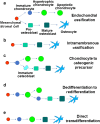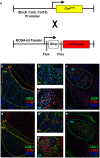The art of building bone: emerging role of chondrocyte-to-osteoblast transdifferentiation in endochondral ossification
- PMID: 29928541
- PMCID: PMC6002476
- DOI: 10.1038/s41413-018-0021-z
The art of building bone: emerging role of chondrocyte-to-osteoblast transdifferentiation in endochondral ossification
Abstract
There is a worldwide epidemic of skeletal diseases causing not only a public health issue but also accounting for a sizable portion of healthcare expenditures. The vertebrate skeleton is known to be formed by mesenchymal cells condensing into tissue elements (patterning phase) followed by their differentiation into cartilage (chondrocytes) or bone (osteoblasts) cells within the condensations. During the growth and remodeling phase, bone is formed directly via intramembranous ossification or through a cartilage to bone conversion via endochondral ossification routes. The canonical pathway of the endochondral bone formation process involves apoptosis of hypertrophic chondrocytes followed by vascular invasion that brings in osteoclast precursors to remove cartilage and osteoblast precursors to form bone. However, there is now an emerging role for chondrocyte-to-osteoblast transdifferentiation in the endochondral ossification process. Although the concept of "transdifferentiation" per se is not recent, new data using a variety of techniques to follow the fate of chondrocytes in different bones during embryonic and post-natal growth as well as during fracture repair in adults have identified three different models for chondrocyte-to-osteoblast transdifferentiation (direct transdifferentiation, dedifferentiation to redifferentiation, and chondrocyte to osteogenic precursor). This review focuses on the emerging models of chondrocyte-to-osteoblast transdifferentiation and their implications for the treatment of skeletal diseases as well as the possible signaling pathways that contribute to chondrocyte-to-osteoblast transdifferentiation processes.
Conflict of interest statement
The authors declare that they have no conflict of interest.
Figures




Similar articles
-
The Emerging Role of Cell Transdifferentiation in Skeletal Development and Diseases.Int J Mol Sci. 2022 May 26;23(11):5974. doi: 10.3390/ijms23115974. Int J Mol Sci. 2022. PMID: 35682655 Free PMC article. Review.
-
Chondrocyte-to-osteoblast transformation in mandibular fracture repair.J Orthop Res. 2021 Aug;39(8):1622-1632. doi: 10.1002/jor.24904. Epub 2020 Nov 18. J Orthop Res. 2021. PMID: 33140859 Free PMC article.
-
Chondrocytes transdifferentiate into osteoblasts in endochondral bone during development, postnatal growth and fracture healing in mice.PLoS Genet. 2014 Dec 4;10(12):e1004820. doi: 10.1371/journal.pgen.1004820. eCollection 2014 Dec. PLoS Genet. 2014. PMID: 25474590 Free PMC article.
-
Bone tissue and histological and molecular events during development of the long bones.Ann Anat. 2021 May;235:151704. doi: 10.1016/j.aanat.2021.151704. Epub 2021 Feb 16. Ann Anat. 2021. PMID: 33600952 Review.
-
Comparative Study of DHA with Different Molecular Forms for Ameliorating Osteoporosis by Promoting Chondrocyte-to-Osteoblast Transdifferentiation in the Growth Plate of Ovariectomized Mice.J Agric Food Chem. 2021 Sep 15;69(36):10562-10571. doi: 10.1021/acs.jafc.1c03228. Epub 2021 Aug 31. J Agric Food Chem. 2021. PMID: 34464107
Cited by
-
Coupling Osteogenesis and Vasculogenesis in Engineered Orthopedic Tissues.Tissue Eng Part B Rev. 2021 Jun;27(3):199-214. doi: 10.1089/ten.TEB.2020.0132. Epub 2020 Sep 25. Tissue Eng Part B Rev. 2021. PMID: 32854589 Free PMC article. Review.
-
Runx3 regulates chondrocyte phenotype by controlling multiple genes involved in chondrocyte proliferation and differentiation.Mol Biol Rep. 2020 Aug;47(8):5773-5792. doi: 10.1007/s11033-020-05646-6. Epub 2020 Jul 13. Mol Biol Rep. 2020. PMID: 32661874
-
The hypertrophic chondrocyte: To be or not to be.Histol Histopathol. 2021 Oct;36(10):1021-1036. doi: 10.14670/HH-18-355. Epub 2021 Jun 17. Histol Histopathol. 2021. PMID: 34137454 Free PMC article. Review.
-
Filling the Gap: Neural Stem Cells as A Promising Therapy for Spinal Cord Injury.Pharmaceuticals (Basel). 2019 Apr 29;12(2):65. doi: 10.3390/ph12020065. Pharmaceuticals (Basel). 2019. PMID: 31035689 Free PMC article. Review.
-
Allogeneic vs. autologous mesenchymal stem/stromal cells in their medication practice.Cell Biosci. 2021 Nov 2;11(1):187. doi: 10.1186/s13578-021-00698-y. Cell Biosci. 2021. PMID: 34727974 Free PMC article. Review.
References
Grants and funding
LinkOut - more resources
Full Text Sources
Other Literature Sources

